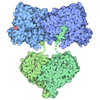[English] 日本語
 Yorodumi
Yorodumi- PDB-6vpg: TPX2 residues 7-20 fused to Aurora A residues 116-389 in complex ... -
+ Open data
Open data
- Basic information
Basic information
| Entry | Database: PDB / ID: 6vpg | |||||||||||||||
|---|---|---|---|---|---|---|---|---|---|---|---|---|---|---|---|---|
| Title | TPX2 residues 7-20 fused to Aurora A residues 116-389 in complex with AMP-PNP | |||||||||||||||
 Components Components | TPX2 fragment - Aurora A kinase domain fusion | |||||||||||||||
 Keywords Keywords | TRANSFERASE / Ser/Thr kinase | |||||||||||||||
| Function / homology |  Function and homology information Function and homology informationactivation of protein kinase activity / Interaction between PHLDA1 and AURKA / regulation of centrosome cycle / axon hillock / negative regulation of microtubule depolymerization / spindle assembly involved in female meiosis I / cilium disassembly / spindle pole centrosome / microtubule nucleation / chromosome passenger complex ...activation of protein kinase activity / Interaction between PHLDA1 and AURKA / regulation of centrosome cycle / axon hillock / negative regulation of microtubule depolymerization / spindle assembly involved in female meiosis I / cilium disassembly / spindle pole centrosome / microtubule nucleation / chromosome passenger complex / importin-alpha family protein binding / histone H3S10 kinase activity / positive regulation of oocyte maturation / mitotic centrosome separation / pronucleus / germinal vesicle / protein localization to centrosome / meiotic spindle / anterior/posterior axis specification / neuron projection extension / spindle organization / centrosome localization / positive regulation of mitochondrial fission / mitotic spindle pole / spindle midzone / SUMOylation of DNA replication proteins / mitotic spindle assembly / intercellular bridge / negative regulation of protein binding / regulation of G2/M transition of mitotic cell cycle / centriole / positive regulation of mitotic nuclear division / protein serine/threonine/tyrosine kinase activity / liver regeneration / positive regulation of mitotic cell cycle / TP53 Regulates Transcription of Genes Involved in G2 Cell Cycle Arrest / molecular function activator activity / regulation of mitotic spindle organization / AURKA Activation by TPX2 / regulation of signal transduction by p53 class mediator / protein serine/threonine kinase activator activity / mitotic spindle organization / regulation of cytokinesis / APC/C:Cdh1 mediated degradation of Cdc20 and other APC/C:Cdh1 targeted proteins in late mitosis/early G1 / FBXL7 down-regulates AURKA during mitotic entry and in early mitosis / peptidyl-serine phosphorylation / regulation of protein stability / kinetochore / response to wounding / G2/M transition of mitotic cell cycle / spindle / spindle pole / mitotic spindle / Regulation of PLK1 Activity at G2/M Transition / positive regulation of proteasomal ubiquitin-dependent protein catabolic process / mitotic cell cycle / protein autophosphorylation / microtubule cytoskeleton / midbody / basolateral plasma membrane / Regulation of TP53 Activity through Phosphorylation / molecular adaptor activity / proteasome-mediated ubiquitin-dependent protein catabolic process / microtubule / protein phosphorylation / non-specific serine/threonine protein kinase / protein kinase activity / postsynaptic density / ciliary basal body / protein heterodimerization activity / negative regulation of gene expression / cell division / protein serine kinase activity / protein serine/threonine kinase activity / apoptotic process / ubiquitin protein ligase binding / centrosome / protein kinase binding / negative regulation of apoptotic process / perinuclear region of cytoplasm / glutamatergic synapse / nucleoplasm / ATP binding / nucleus / cytosol Similarity search - Function | |||||||||||||||
| Biological species |  Homo sapiens (human) Homo sapiens (human) | |||||||||||||||
| Method |  X-RAY DIFFRACTION / X-RAY DIFFRACTION /  MOLECULAR REPLACEMENT / MOLECULAR REPLACEMENT /  molecular replacement / Resolution: 2.64 Å molecular replacement / Resolution: 2.64 Å | |||||||||||||||
 Authors Authors | Lim, D.C. / Yaffe, M.B. | |||||||||||||||
| Funding support |  United States, 4items United States, 4items
| |||||||||||||||
 Citation Citation |  Journal: Sci.Signal. / Year: 2020 Journal: Sci.Signal. / Year: 2020Title: Redox priming promotes Aurora A activation during mitosis. Authors: Lim, D.C. / Joukov, V. / Rettenmaier, T.J. / Kumagai, A. / Dunphy, W.G. / Wells, J.A. / Yaffe, M.B. | |||||||||||||||
| History |
|
- Structure visualization
Structure visualization
| Structure viewer | Molecule:  Molmil Molmil Jmol/JSmol Jmol/JSmol |
|---|
- Downloads & links
Downloads & links
- Download
Download
| PDBx/mmCIF format |  6vpg.cif.gz 6vpg.cif.gz | 138.6 KB | Display |  PDBx/mmCIF format PDBx/mmCIF format |
|---|---|---|---|---|
| PDB format |  pdb6vpg.ent.gz pdb6vpg.ent.gz | 107 KB | Display |  PDB format PDB format |
| PDBx/mmJSON format |  6vpg.json.gz 6vpg.json.gz | Tree view |  PDBx/mmJSON format PDBx/mmJSON format | |
| Others |  Other downloads Other downloads |
-Validation report
| Summary document |  6vpg_validation.pdf.gz 6vpg_validation.pdf.gz | 791.7 KB | Display |  wwPDB validaton report wwPDB validaton report |
|---|---|---|---|---|
| Full document |  6vpg_full_validation.pdf.gz 6vpg_full_validation.pdf.gz | 793.1 KB | Display | |
| Data in XML |  6vpg_validation.xml.gz 6vpg_validation.xml.gz | 13.4 KB | Display | |
| Data in CIF |  6vpg_validation.cif.gz 6vpg_validation.cif.gz | 17.6 KB | Display | |
| Arichive directory |  https://data.pdbj.org/pub/pdb/validation_reports/vp/6vpg https://data.pdbj.org/pub/pdb/validation_reports/vp/6vpg ftp://data.pdbj.org/pub/pdb/validation_reports/vp/6vpg ftp://data.pdbj.org/pub/pdb/validation_reports/vp/6vpg | HTTPS FTP |
-Related structure data
| Related structure data | 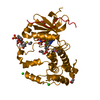 6vphC 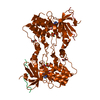 6vpiC 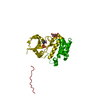 6vpjC  6vplC  6vpmC 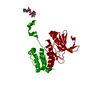 6xkaC 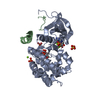 1ol5S S: Starting model for refinement C: citing same article ( |
|---|---|
| Similar structure data |
- Links
Links
- Assembly
Assembly
| Deposited unit | 
| ||||||||
|---|---|---|---|---|---|---|---|---|---|
| 1 |
| ||||||||
| Unit cell |
|
- Components
Components
-Protein , 1 types, 1 molecules A
| #1: Protein | Mass: 34066.715 Da / Num. of mol.: 1 / Fragment: kinase domain,kinase domain Source method: isolated from a genetically manipulated source Source: (gene. exp.)  Homo sapiens (human) Homo sapiens (human)Gene: TPX2, C20orf1, C20orf2, DIL2, HCA519, AURKA, AIK, AIRK1, ARK1, AURA, AYK1, BTAK, IAK1, STK15, STK6 Plasmid: pET28a / Production host:  References: UniProt: Q9ULW0, UniProt: O14965, non-specific serine/threonine protein kinase |
|---|
-Non-polymers , 5 types, 68 molecules 








| #2: Chemical | ChemComp-ANP / | ||||
|---|---|---|---|---|---|
| #3: Chemical | ChemComp-GOL / | ||||
| #4: Chemical | | #5: Chemical | ChemComp-MG / | #6: Water | ChemComp-HOH / | |
-Details
| Has ligand of interest | Y |
|---|---|
| Has protein modification | Y |
-Experimental details
-Experiment
| Experiment | Method:  X-RAY DIFFRACTION / Number of used crystals: 1 X-RAY DIFFRACTION / Number of used crystals: 1 |
|---|
- Sample preparation
Sample preparation
| Crystal | Density Matthews: 2.93 Å3/Da / Density % sol: 58.08 % / Mosaicity: 0.705 ° |
|---|---|
| Crystal grow | Temperature: 298 K / Method: evaporation / pH: 7 Details: 0.1 M HEPES pH 7, 0.9 M KCl, 1.08 M ammonium sulfate, 12% glycerol |
-Data collection
| Diffraction | Mean temperature: 100 K / Serial crystal experiment: N | |||||||||||||||||||||||||||||||||||||||||||||||||||||||||||||||||||||||||||||||||||||||||||||||||||
|---|---|---|---|---|---|---|---|---|---|---|---|---|---|---|---|---|---|---|---|---|---|---|---|---|---|---|---|---|---|---|---|---|---|---|---|---|---|---|---|---|---|---|---|---|---|---|---|---|---|---|---|---|---|---|---|---|---|---|---|---|---|---|---|---|---|---|---|---|---|---|---|---|---|---|---|---|---|---|---|---|---|---|---|---|---|---|---|---|---|---|---|---|---|---|---|---|---|---|---|---|
| Diffraction source | Source:  ROTATING ANODE / Type: RIGAKU MICROMAX-007 / Wavelength: 1.5418 Å ROTATING ANODE / Type: RIGAKU MICROMAX-007 / Wavelength: 1.5418 Å | |||||||||||||||||||||||||||||||||||||||||||||||||||||||||||||||||||||||||||||||||||||||||||||||||||
| Detector | Type: RIGAKU RAXIS IV++ / Detector: IMAGE PLATE / Date: Sep 12, 2011 / Details: mirrors | |||||||||||||||||||||||||||||||||||||||||||||||||||||||||||||||||||||||||||||||||||||||||||||||||||
| Radiation | Monochromator: mirrors / Protocol: SINGLE WAVELENGTH / Monochromatic (M) / Laue (L): M / Scattering type: x-ray | |||||||||||||||||||||||||||||||||||||||||||||||||||||||||||||||||||||||||||||||||||||||||||||||||||
| Radiation wavelength | Wavelength: 1.5418 Å / Relative weight: 1 | |||||||||||||||||||||||||||||||||||||||||||||||||||||||||||||||||||||||||||||||||||||||||||||||||||
| Reflection | Resolution: 2.64→30 Å / Num. obs: 12410 / % possible obs: 99.8 % / Redundancy: 4.9 % / Rmerge(I) obs: 0.074 / Rpim(I) all: 0.037 / Rrim(I) all: 0.083 / Χ2: 1.057 / Net I/σ(I): 25.7 | |||||||||||||||||||||||||||||||||||||||||||||||||||||||||||||||||||||||||||||||||||||||||||||||||||
| Reflection shell | Diffraction-ID: 1
|
-Phasing
| Phasing | Method:  molecular replacement molecular replacement |
|---|
- Processing
Processing
| Software |
| |||||||||||||||||||||||||||||||||||||||||||||||||||||||||||||||||||||||||||||||||||||||||||||||||||||||||||||||||||||||||||||
|---|---|---|---|---|---|---|---|---|---|---|---|---|---|---|---|---|---|---|---|---|---|---|---|---|---|---|---|---|---|---|---|---|---|---|---|---|---|---|---|---|---|---|---|---|---|---|---|---|---|---|---|---|---|---|---|---|---|---|---|---|---|---|---|---|---|---|---|---|---|---|---|---|---|---|---|---|---|---|---|---|---|---|---|---|---|---|---|---|---|---|---|---|---|---|---|---|---|---|---|---|---|---|---|---|---|---|---|---|---|---|---|---|---|---|---|---|---|---|---|---|---|---|---|---|---|---|
| Refinement | Method to determine structure:  MOLECULAR REPLACEMENT MOLECULAR REPLACEMENTStarting model: 1OL5 Resolution: 2.64→27.08 Å / SU ML: 0.38 / Cross valid method: THROUGHOUT / σ(F): 1.34 / Phase error: 27.68
| |||||||||||||||||||||||||||||||||||||||||||||||||||||||||||||||||||||||||||||||||||||||||||||||||||||||||||||||||||||||||||||
| Solvent computation | Shrinkage radii: 0.9 Å / VDW probe radii: 1.11 Å | |||||||||||||||||||||||||||||||||||||||||||||||||||||||||||||||||||||||||||||||||||||||||||||||||||||||||||||||||||||||||||||
| Displacement parameters | Biso max: 215.38 Å2 / Biso min: 42.59 Å2 | |||||||||||||||||||||||||||||||||||||||||||||||||||||||||||||||||||||||||||||||||||||||||||||||||||||||||||||||||||||||||||||
| Refinement step | Cycle: final / Resolution: 2.64→27.08 Å
| |||||||||||||||||||||||||||||||||||||||||||||||||||||||||||||||||||||||||||||||||||||||||||||||||||||||||||||||||||||||||||||
| LS refinement shell | Refine-ID: X-RAY DIFFRACTION / Rfactor Rfree error: 0 / Total num. of bins used: 9
| |||||||||||||||||||||||||||||||||||||||||||||||||||||||||||||||||||||||||||||||||||||||||||||||||||||||||||||||||||||||||||||
| Refinement TLS params. | Method: refined / Refine-ID: X-RAY DIFFRACTION
| |||||||||||||||||||||||||||||||||||||||||||||||||||||||||||||||||||||||||||||||||||||||||||||||||||||||||||||||||||||||||||||
| Refinement TLS group |
|
 Movie
Movie Controller
Controller


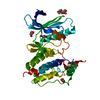
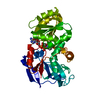

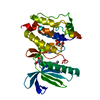
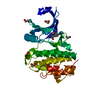


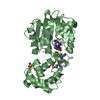
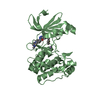

 PDBj
PDBj













